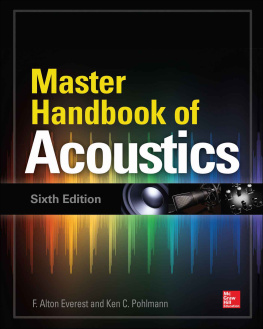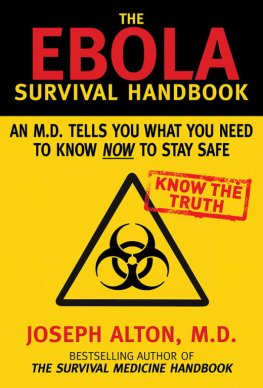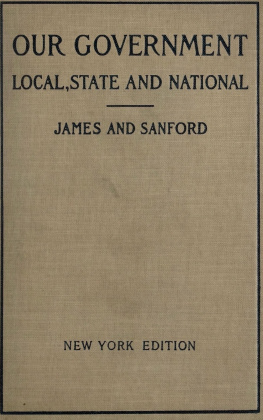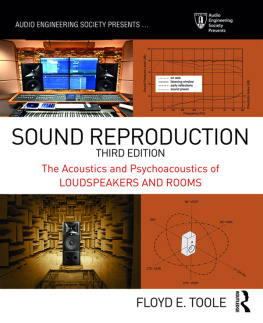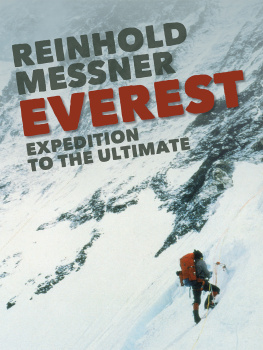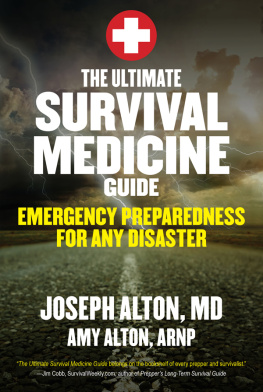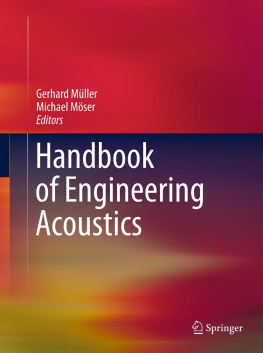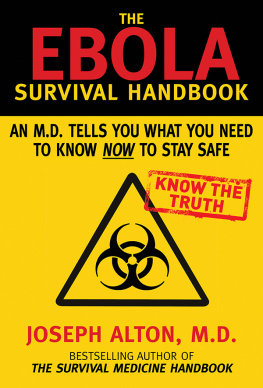Everest Frederick Alton - Master handbook of acoustics
Here you can read online Everest Frederick Alton - Master handbook of acoustics full text of the book (entire story) in english for free. Download pdf and epub, get meaning, cover and reviews about this ebook. year: 2014, publisher: McGraw-Hill Education, genre: Science / Computer. Description of the work, (preface) as well as reviews are available. Best literature library LitArk.com created for fans of good reading and offers a wide selection of genres:
Romance novel
Science fiction
Adventure
Detective
Science
History
Home and family
Prose
Art
Politics
Computer
Non-fiction
Religion
Business
Children
Humor
Choose a favorite category and find really read worthwhile books. Enjoy immersion in the world of imagination, feel the emotions of the characters or learn something new for yourself, make an fascinating discovery.
- Book:Master handbook of acoustics
- Author:
- Publisher:McGraw-Hill Education
- Genre:
- Year:2014
- Rating:4 / 5
- Favourites:Add to favourites
- Your mark:
- 80
- 1
- 2
- 3
- 4
- 5
Master handbook of acoustics: summary, description and annotation
We offer to read an annotation, description, summary or preface (depends on what the author of the book "Master handbook of acoustics" wrote himself). If you haven't found the necessary information about the book — write in the comments, we will try to find it.
Master handbook of acoustics — read online for free the complete book (whole text) full work
Below is the text of the book, divided by pages. System saving the place of the last page read, allows you to conveniently read the book "Master handbook of acoustics" online for free, without having to search again every time where you left off. Put a bookmark, and you can go to the page where you finished reading at any time.
Font size:
Interval:
Bookmark:
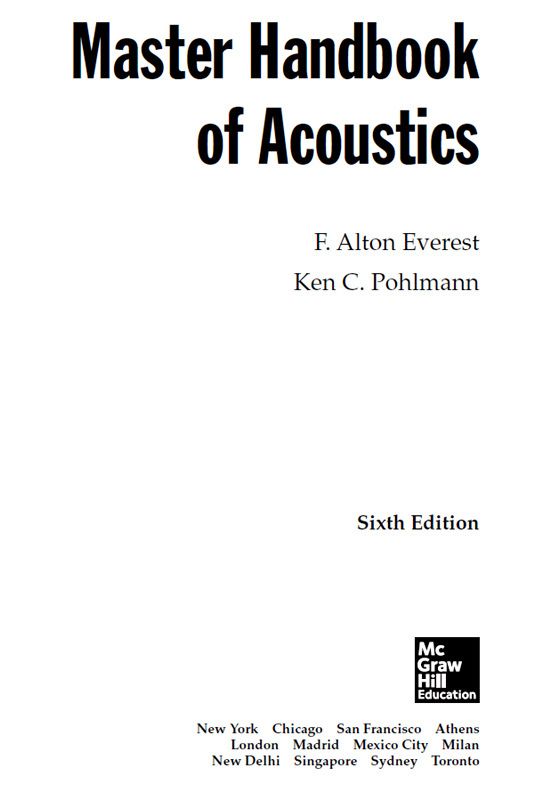
Copyright 2015 by McGraw-Hill Education. All rights reserved. Except as permitted under the United States Copyright Act of 1976, no part of this publication may be reproduced or distributed in any form or by any means, or stored in a database or retrieval system, without the prior written permission of the publisher.
ISBN: 978-0-07-184103-0
MHID: 0-07-184103-2
The material in this eBook also appears in the print version of this title: ISBN: 978-0-07-184104-7, MHID: 0-07-184104-0.
eBook conversion by codeMantra
Version 1.0
All trademarks are trademarks of their respective owners. Rather than put a trademark symbol after every occurrence of a trademarked name, we use names in an editorial fashion only, and to the benefit of the trademark owner, with no intention of infringement of the trademark. Where such designations appear in this book, they have been printed with initial caps.
McGraw-Hill Education eBooks are available at special quantity discounts to use as premiums and sales promotions or for use in corporate training programs. To contact a representative, please visit the Contact Us page at www.mhprofessional.com.
Information contained in this work has been obtained by McGraw-Hill Education from sources believed to be reliable. However, neither McGraw-Hill Education nor its authors guarantee the accuracy or completeness of any information published herein, and neither McGraw-Hill Education nor its authors shall be responsible for any errors, omissions, or damages arising out of use of this information. This work is published with the understanding that McGraw-Hill Education and its authors are supplyin information but are not attempting to render engineering or other professional services. If such services are required, the assistance of an appropriate professional should be sought.
TERMS OF USE
This is a copyrighted work and McGraw-Hill Education and its licensors reserve all rights in and to the work. Use of this work is subject to these terms. Except as permitted under the Copyright Act of 1976 and the right to store and retrieve one copy of the work, you may not decompile, disassemble, reverse engineer, reproduce, modify, create derivative works based upon, transmit, distribute, disseminate, sell, publish or sublicense the work or any part of it without McGraw-Hill Educations prior consent. You may use the work for your own noncommercial and personal use; any other use of the work is strictly prohibited. Your right to use the work may be terminated if you fail to comply with these terms.
THE WORK IS PROVIDED AS IS. MCGRAW-HILL EDUCATION AND ITS LICENSORS MAKE NO GUARANTEES OR WARRANTIES AS TO THE ACCURACY, ADEQUACY OR COMPLETENESS OF OR RESULTS TO BE OBTAINED FROM USING THE WORK, INCLUDING ANY INFORMATION THAT CAN BE ACCESSED THROUGH THE WORK VIA HYPERLINK OR OTHERWISE, AND EXPRESSLY DISCLAIM ANY WARRANTY, EXPRESS OR IMPLIED, INCLUDING BUT NOT LIMITED TO IMPLIED WARRANTIES OF MERCHANTABILITY OR FITNESS FOR A PARTICULAR PURPOSE. McGraw-Hill Education and its licensors do not warrant or guarantee that the functions contained in the work will meet your requirements or that its operation will be uninterrupted or error free. Neither McGraw-Hill Education nor its licensors shall be liable to you or anyone else for any inaccuracy, error or omission, regardless of cause, in the work or for any damages resulting therefrom. McGraw-Hill Education has no responsibility for the content of any information accessed through the work. Under no circumstances shall McGraw-Hill Education and/or its licensors be liable for any indirect, incidental, special, punitive, consequential or similar damages that result from the use of or inability to use the work, even if any of them has been advised of the possibility of such damages. This limitation of liability shall apply to any claim or cause whatsoever whether such claim or cause arises in contract, tort or otherwise.
Dedicated to the memory of F. Alton Everest
F. Alton Everest (deceased) was a leading expert and authority in the field of acoustics. He was an emeritus member of the Acoustical Society of America, a life member of the Institute of Electrical and Electronics Engineers, and life fellow of the Society of Motion Picture and Television Engineers. He was cofounder and director of the Science Film Production division of the Moody Institute of Science, and was also section chief of the Subsea Sound Research section of the University of California.
Ken C. Pohlmann is well known as an audio educator, consultant, and author. He was director of the Music Engineering Technology program, founder of its Master of Science degree program, and is professor emeritus, at the University of Miami in Coral Gables. He is a fellow of the Audio Engineering Society, a consultant for numerous audio companies and car manufacturers, and an expert in patent-infringement litigation. He is author of numerous articles and books including Principles of Digital Audio (McGraw-Hill), and coauthor of Sound Studio Construction(McGraw-Hill).
Contributions are included from Peter DAntonio, Geoff Goacher, and Doug Plum.


I have traveled the world, poking my head into research laboratories, anechoic chambers, engineering cubicles, recording studios, home theaters, and countless classrooms. Often tucked away with other books is a copy of the Master Handbook of Acoustics. Ive seen old editions, new editions, and everything in between. I am especially happy to see the well-used print copies with dog-eared covers and underlined passages. All of this is testament to Mr. F. Alton Everest, the original author of the book. He created a valuable tool that we know and trust, a book that has become a classic. The acoustical engineering community grieved when Mr. Everest passed away in 2005 at the age of 95. He was a giant in the field of acoustics, and a great example of the high caliber of the engineers of his generation. He will be missed.
I was honored when McGraw-Hill asked me to prepare a fifth, and now this sixth edition of the Master Handbook of Acoustics. I had used the handbook since it was first published in 1981, and was well familiar with its value as a teaching text and reference book. Readers who are familiar with another of my books, Principles of Digital Audio, may be surprised to learn that my passion for digital technology is equaled by my enthusiasm for acoustics. I taught courses in architectural acoustics (in addition to classes in digital audio) for 30 years at the University of Miami, where I directed the Music Engineering Technology program. Throughout that time, I also consulted on many acoustics projects, ranging from recording studio to listening room design, from church acoustics to community noise intrusion. As with many practitioners in the field, it was important for me to understand the fundamentals of acoustical properties, and also to stay current with the practical applications and solutions to todays acoustical problems. This essential equilibrium was the guiding principle of Mr. Everests previous editions of this book, and I have continued to seek that same balance.
Occasionally, and particularly among newbies to the field of acoustics, the question arises, Why is it important to study acoustics? One reason, among many, is that you will be joining in, and hopefully contributing to, a noble scientific undertaking. Since antiquity, some of the worlds greatest scientists and engineers have studied acoustics and its elegant complexities. Greek philosophers including Pythagoras, Aristotle, and Euclid began the exploration of the nature of musical harmonics and how we hear sound. The great Roman engineer and architect Vitruvius carefully analyzed echo and reverberation in his building projects. Over the years, heavyweights such as Ptolemy, Galileo, Mersenne, Kircher, Hooke, Newton, Laplace, Euler, DAlembert, Bernoulli, Lagrange, Poisson, Faraday, Helmholtz, Ohm, Doppler, and Sabine all made contributions. In all, countless men and women have worked to evolve the science of acoustics to a high degree of sophistication. But, pressing the question, in todays binary world, is acoustics still important? Consider this: We rely on our eyes and ears. Our eyes close when we sleep; we cannot see in the dark; someone can sneak up on us unseen from behind. But from birth to death, awake or asleep, in light and in dark, our ears are always sensitive to our world all around us. Whether we are hearing sounds that give us pleasure, or sounds that alert us to danger, whether they are sounds of nature, or sounds of technology, the properties of acoustics and the way that architectural spaces affect those sounds is woven into every moment of our lives. Is acoustics important? You bet it is.
Font size:
Interval:
Bookmark:
Similar books «Master handbook of acoustics»
Look at similar books to Master handbook of acoustics. We have selected literature similar in name and meaning in the hope of providing readers with more options to find new, interesting, not yet read works.
Discussion, reviews of the book Master handbook of acoustics and just readers' own opinions. Leave your comments, write what you think about the work, its meaning or the main characters. Specify what exactly you liked and what you didn't like, and why you think so.

